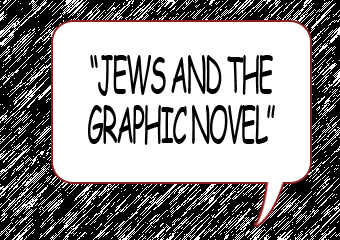“Jews and the graphic novel”
Permanent link All Posts

Jews are some of the most famous novelists, and Jews also are some of the most important people in the superhero-type comic-book world. So it’s no big surprise that Jews are some of the most famous, most important people in the genre that conflates the two: graphic novels. What’s surprising is that so many Jewish graphic novelists have focused on Jewish experiences for their subject matter.
So many, in fact, that essays on this topic have been collected into—what else?—a book, titled Jews and the Graphic Novel by David Gantz. There are many books about Jewish artists and subjects in superhero comics (see below), and one or two about individual Jewish graphic novelists. But Jews and the Graphic Novel seems to be the first book covering Jewish involvement in this genre as a whole.
Jews and the Graphic Novel starts at the same place where many discussions of “the graphic novel as art” start— with the work of Will Eisner, the Jewish man largely credited with creating the graphic novel altogether. His first major work, the 1978 A Contract With God, is a series of stories based on the life of Jews in the (in)famous Lower East Side tenements and their Heaven-on-Earth, the Borscht Belt. While it is not the first graphic novel, it is one of the first to have a basis in “real life” as opposed to a fantasy/sci-fi/superhero setting. Eisner’s other Jewish work includes stories of immigration, assimilation, anti-Semitism, and even a retelling of Oliver Twist from Fagin’s point of view. Eisner, who also created the character The Spirit, became so respected, his colleagues created the Eisner Award for achievement in graphic novels… and accolade he would later win himself! His last work was also Jewish in subject; The Plot traces the history of the pernicious forgeries known as “The Protocols of the Elders of Zion.”
The next major milestone in Jewish graphic novel-ing has got to be Art Spiegelman’s Maus in 1986, which depicted Jews as mice, Nazis as cats, and Americans as dogs. Spiegelman’s landmark effort was listed as a bestseller in the New York Times’ list under fiction until he protested that all the facts and stories in the work were true, so they moved it to their non-fiction list. It may be the first book ever to make in both lists; in any case, it won the Pulitzer. More recently, Speigelman wrote In The Shadow of No Towers, a rumination on September 11.
Since Maus, there has been an explosion of graphic novels on Jewish themes. There are a few that cover the expected subjects, like the Torah, Chanukah and Purim stories. One brand-new standout is Book of Genesis by non-Jewish artist R. Crumb, who also wrote a graphic bio Kafka. Another startling work is the excruciatingly researched, starkly black-and-white Megillat Esther by J.T. Waldman.
Others, like Eisner’s work, continue to cover the anomie of urban life. The best of these includes the novels of Ben Katchor, like The Jew of New York, about the historical attempt at a Jewish utopia in the 1800s by a remarkable man with the appropos last name of Noah.
Aside from Maus, the most famous Jewish graphic novel must be one of the few made into a movie— Harvey Pekar’s American Splendor . Pekar and his wife, Joyce Brabner, also wrote Our Cancer Year, and Miriam Engelberg also dealt with his topic in Cancer Made Me a Shallower Person. Another work about struggles with illness is Neil Kleid’s Migdal David, a memoir about an Orthodox boy and his developmentally disabled brother.
Still other graphic novels discuss more out-of-the way aspects of Jewish-American history, such as The Adventures of Rabbi Harvey: A Graphic Novel of Jewish Wisdom and Wit in the Wild West by Steve Sheinkin… The Golem’s Mighty Swing by James Sturm, about 1920s Jewish ballplayers… and Houdini: The Handcuff King, by Jason Lutes and Nick Bertozzi. Joe Kubert, whose novel Yossel is about the Warsaw Ghetto Uprising, also wrote Jew Gangster; Neil Kleid and Jake Allen’s Brownsville likewise covers the Jewish mob world.
Of course, there has been Jewish life outside of America and Europe. Joann Sfar’s The Rabbi’s Cat and Aryeh Mahr’s Shmuel Ha Nagid: a Tale of the Golden Age are set in the Sephardic world.
Marv Wolfman’s Homeland tells the official story of Zionism and the creation of the modern nation of Israel… while Jetlag and Pizzeria Kamikaze by Etgar Keret, Exit Wounds by Rutu Modan, and real gone girl by Miriam Libicki paint a more current and visceral portrait of Israeli life.
With both fierce honesty and brilliant imagination, Jewish artists are challenging—and changing— the perspectives their readers. Given the mountainous range of Jewish history and the underdog doggedness of Jewish artists, it’s no wonder that Jewish graphic novels are particularly… graphic.
SOURCES AND FURTHER READING:
A list of Jewish-themed graphic novels, some of which are not mentioned above, can be found here; the ones for adult readers start on the second page.
As mentioned, most of the books that touch on the Jewish relationship with graphic novels mostly focus on the superhero end of the spectrum. Two exceptions, which give graphic novels more time, are Charles Hatfield’s Alternative Comics: An Emerging Literature and Arie Kaplan’s Masters of the Comic Book Universe Revealed!, which includes interviews with Eisner and Spiegelman along with other Jewish artists.



.jpg)



